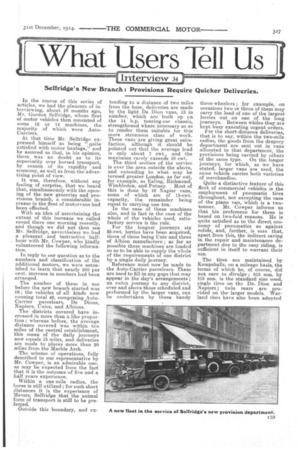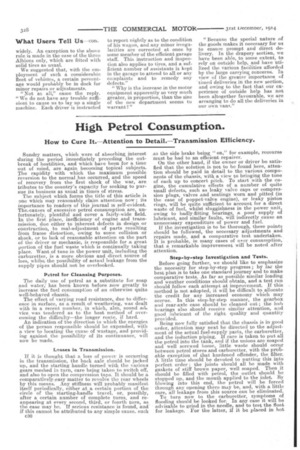Interview 34
Page 11

Page 12

If you've noticed an error in this article please click here to report it so we can fix it.
Selfridge's New Branch : Provisions Require Quicker Deliveries.
In the course of this series of articles, we had the pleasure of interviewing, about 18 months ago, Mr. Gordon Selfridge, whose fleet of motor vehicles then consisted of some 13 or 14 machines, the majority of which were AutoCarriers.
At that time Mr. Selfridge expressed himself as being "quite satisfied with motor haulage," and he assured us that, in his opinion, there was no doubt as to its superiority over horsed transport, by reason of its rapidity and economy, as well as from the advertising point of view.
it was, therefore, without any feeling of surprise, that we heard that, simultaneously with the opening of the new groceries and provisions branch, a considerable increase in the fleet of motorvans had been effected.
With an idea of ascertaining the extent of this increase we called round there one morning recently, and though we did not then see Mr. Selfridge, nevertheless we had a pleasant and instructive halfhour with Mr. Cowper, who kindly volunteered the following information.
In reply to our question as to the numbers and classification of the additional motors, we were astonished to learn that nearly 200 per cent, increase in numbers had been arranged.
The number of these in use before the new branch started was 16 ; the vehicles of all kinds now running total 46, comprising AutoCarrier parcelcars, De Dions, Napiers, Unics, and Albions.
The districts covered have increased in more than a like proportion; whereas before, the average distance covered was within ten miles of the central establishment, this mean of the daily journeys now equals 15 miles, and deliveries are made to places more than 20 miles from the Marble Arch.
The scheme of operations, fully described to our representative by Mr. Cowper, is an admirable one, as may be expected from the fact that it is the outcome of five and a half years experience.
Within a one-mile radius, the horse is still utilized ; for such short distances it is the experience of Messrs. Selfridge that the animal form of transport is still to be pref e ere d,
Outside this boundary, and ex
tending to a distance of two miles from the base, deliveries are made by the light De Dion vans, 13 in number, which are built up en the 14 h.p. touring-car chassis, strengthened where necessary so as to render them suitable for this more strenuous class of work. These vans are giving great satisfaction, although it should be pointed out that the average load is only about 7 cwt., and the maximum rarely exceeds 10 cwt.
The third section of the service is over the area outside the above, and extending to what may be termed greater London, as far out, for example, as Ealing, Richmond, Wimbledon, and Putney. Most of this is done by 16 Napier vans, some of which are of 15-cwt. capacity, the remainder being equal to carrying one ton.
In the case of these machines also, and in fact in the case of the whole of the vehicles used, satisfactory service is the rule.
For the longest journeys . six 25-cwt. lorries have been acquired, three of these being Unic and three of Albion manufacture ; as far as passible these machines are loaded so as to be able to supply the whole of the requirements of one district by a single daily journey.
Reference must now be made to the Auto-Carrier parcelcars. These are used to fill in any gaps that may appear in the day's arrangements ; an extra journey to any district, over and above those scheduled and performed by the larger vans, can be undertaken by these handy three-wheelers ; for example, on occasions two or three of them may carry the load of one of the largest lorries out on one of the long Journeys. Between whiles they are kept busy executing urgent orders.
For the short-distance deliveries' that is to say, within the two-mile radius, the goods from the drapery department are sent out in vans allocated to that department, the provisions being carried by others of the same type. On the longer journeys, for which, as we have stated, larger vans are used, the same vehicle carries both varieties of merchandise.
Quite a distinctive feature of this fleet of commercial vehicles is the employment of pneumatic tires throughout, not excepting the case i of the piano van, which s a twotonner. Mr. Cowper informs us that his preference for these is based on two-fold reasons. He is quite satisfied as to the direct economy of pneumatics as against solids, and, further, is sure that, apart from this, the indirect saving in the repair and maintenance department due to the easy riding, is sufficient in itself to warrant their use.
The tires are maintained by Kempshalls, on a mileage basis, the terms of which he, of course, did not care to divulge • 815 mm. by 105 mm. is the standard size used, single tires on the De. Dion and Napiers ; twin rears are provided on the larger models. Warland rims have also been adopted widely. An exception to the above rule is made in the case of the three Albions only, which are fitted with solid tires as usual.
We suggested that, with the employment of such a considerable fleet of vehicles, a certain percentage would probably be in dock for minor repairs or adjustments.
"Not at all," came the reply. "We do not have any trouble sufficient to cause us to lay up a single machine, Each driver is instructed to report nightly as to the condition of his wagon, and any minor irregularities are corrected at once by some member of the efficient garage staff. This instruction and inspection also applies to tires, and a sufficient number of assistants is kept in the garage to attend to all or any complaints and to remedy any defects."
"Why is the increase in the motor equipment apparently so very much greater, in proportion, than the size of the new department seems to warrant?" "Because the special nature of the goods makes it necessary for us to ensure prompt and direct delivery. In the drapery section, we have been able, to some extent, to rely on outside help, and have utilized the various facilities afforded by the large carrying, concerns. In view of the greater importance of timed deliveries in the new section, and owing to the fact that our experience of outside help has not been altogether favourable, we are arranging to do all the deliveries in our own vans."


















